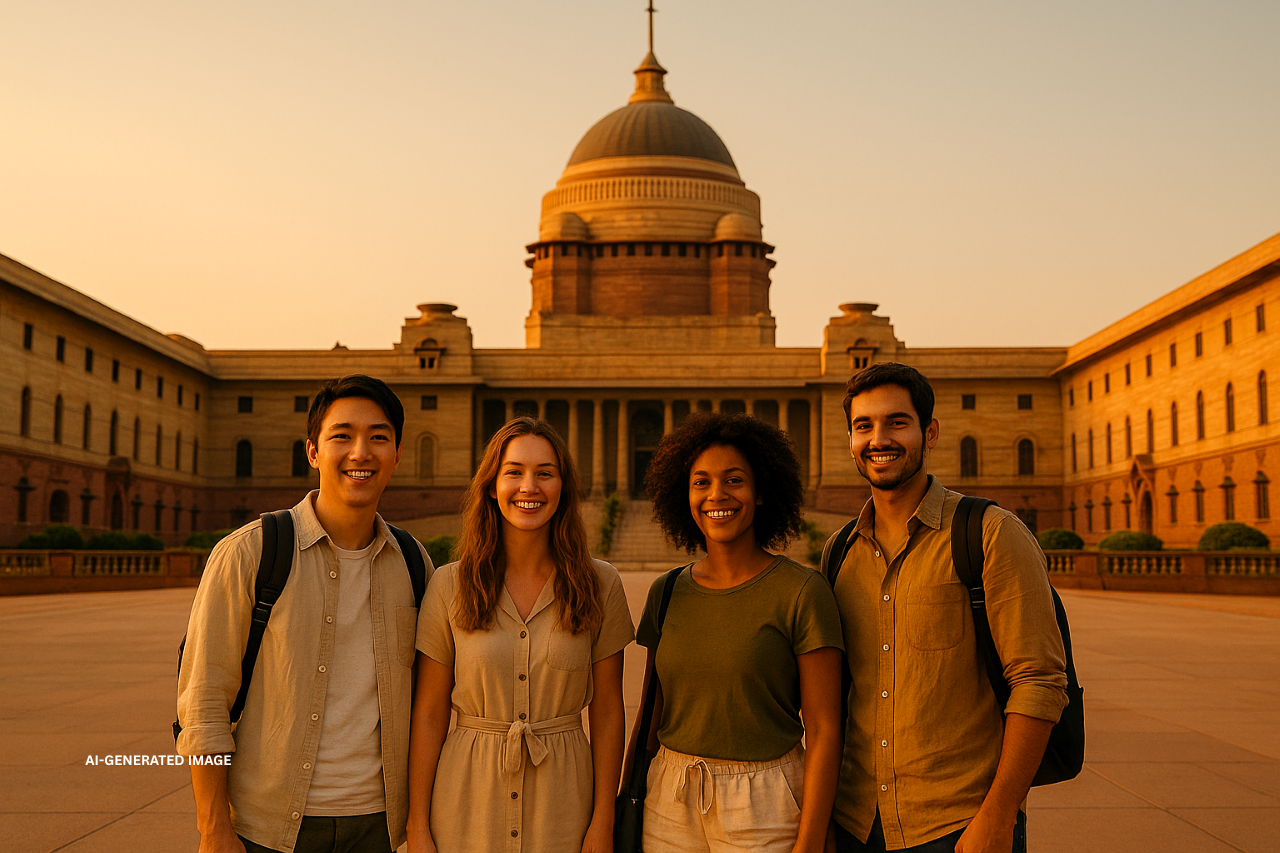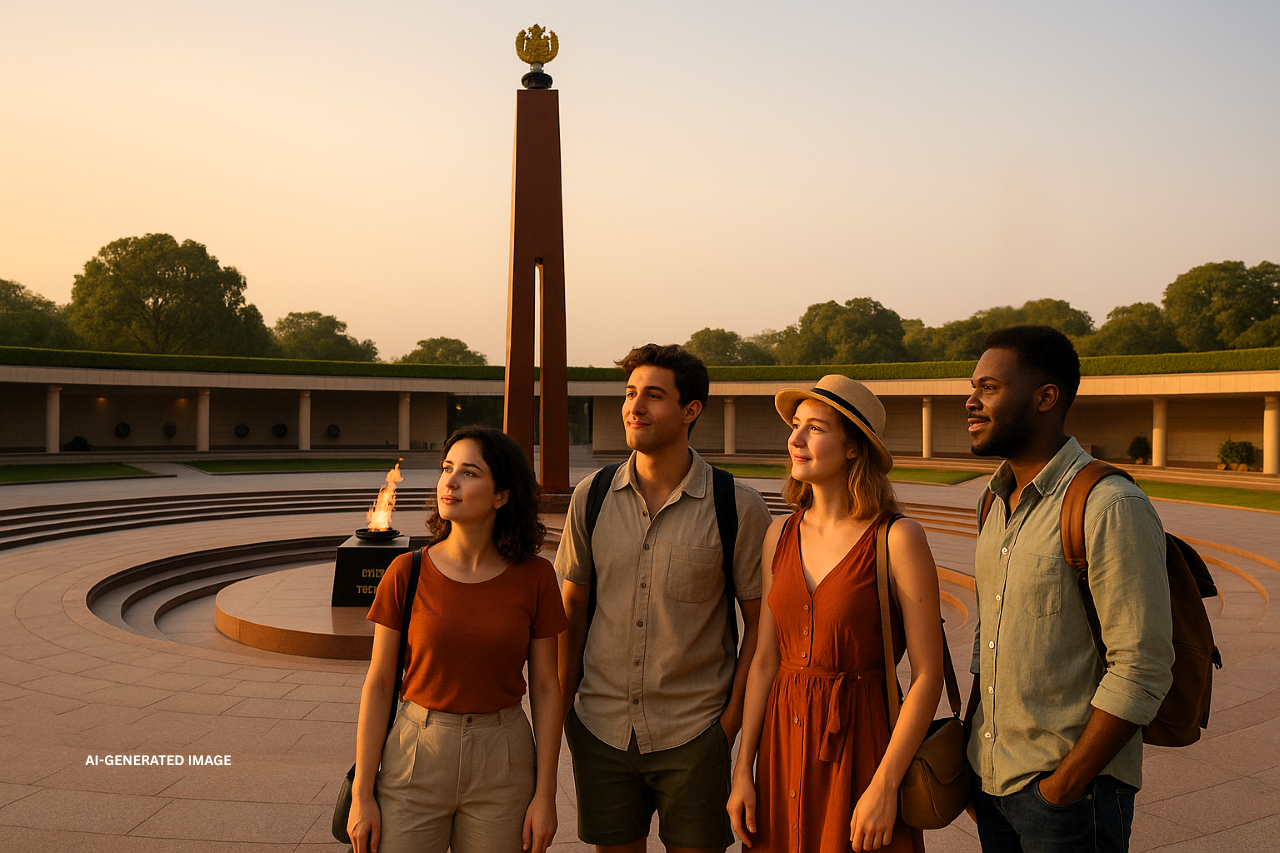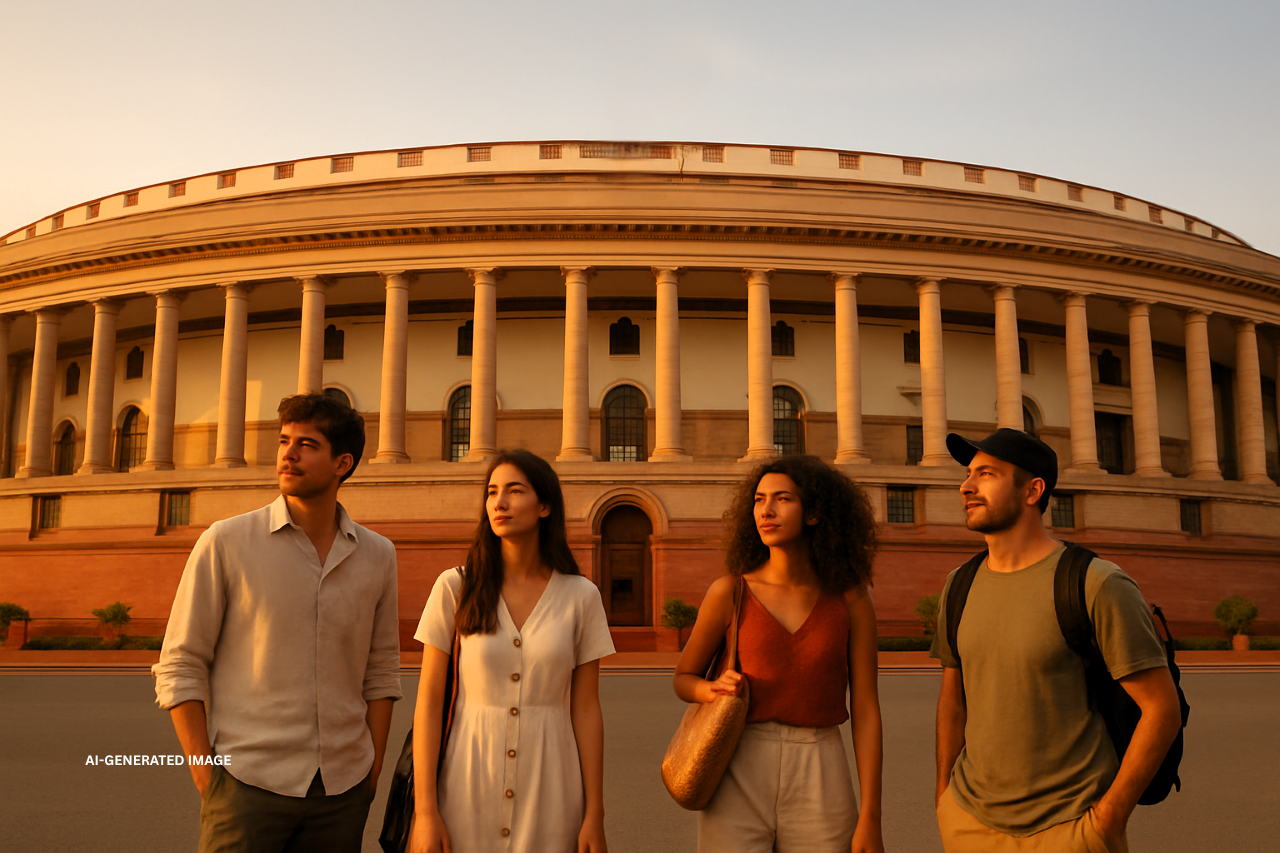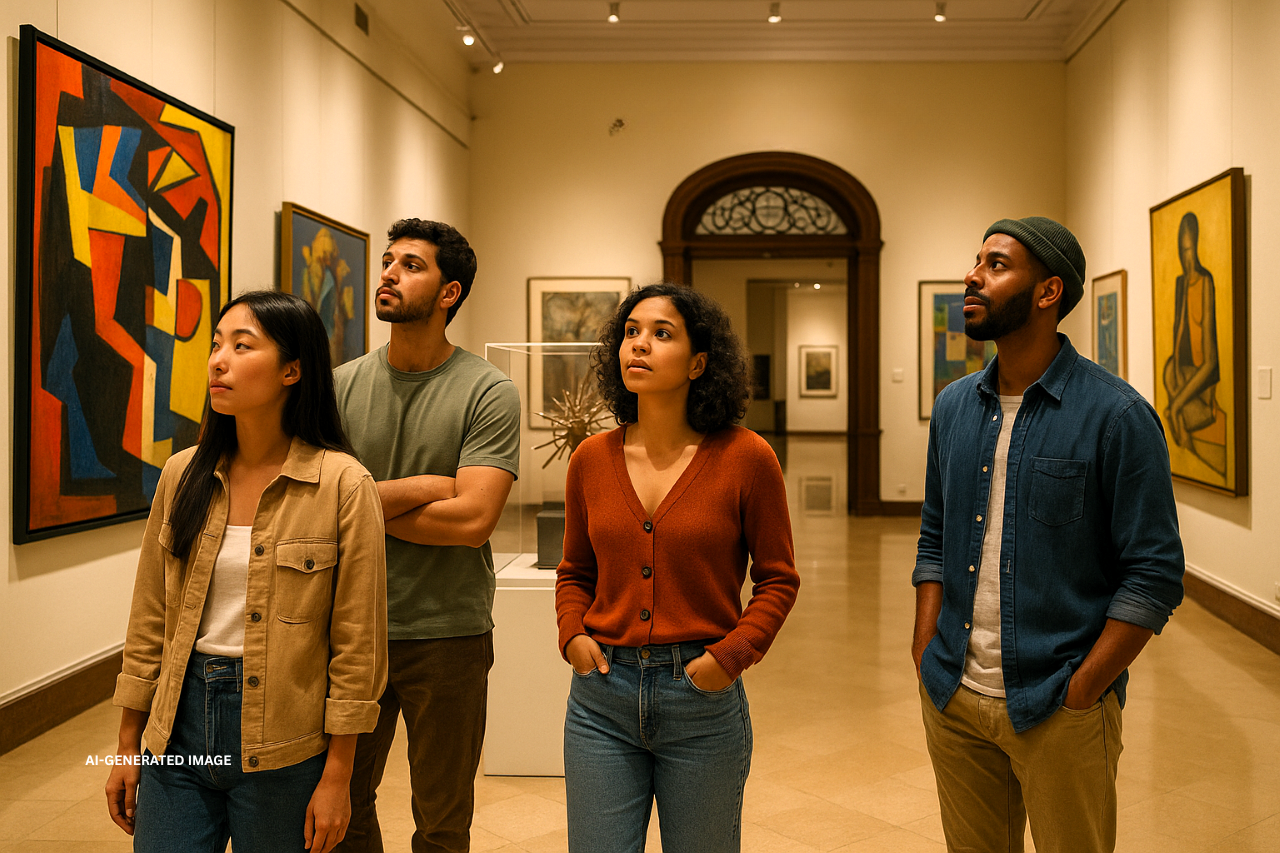Introduction
In the heart of New Delhi stands one of the most iconic monuments of modern India – the India Gate in India. This majestic memorial is not just a piece of architecture but also a powerful symbol of sacrifice, national pride, and heritage. Designed by the celebrated British architect Sir Edwin Lutyens, the structure honors thousands of soldiers of the British Indian Army who lost their lives during World War I and the Third Anglo-Afghan War.
Today, India Gate in Delhi is more than a war memorial. It is a place where history meets culture, a landmark that has become part of India’s national identity. For tourists, the site offers an unforgettable experience – from its commanding presence during the day to its mesmerizing glow when illuminated at night. For locals, the monument is a beloved gathering space, filled with life, street food, and family picnics.
Where is the India Gate Located?
India Gate is situated on Rajpath (now Kartavya Path), one of the most important ceremonial avenues in New Delhi. Stretching from Rashtrapati Bhavan to the monument, this grand boulevard makes the site easily accessible and highly significant. Surrounded by lush gardens, fountains, and wide lawns, the location is not only central but also one of the most scenic parts of the city.
For visitors, India Gate in India is just a short drive from Connaught Place, Delhi’s bustling commercial hub. The monument’s proximity to other major attractions such as Rashtrapati Bhavan and the Parliament House makes it a natural starting point for exploring New Delhi.
Why is the India Gate Famous?
The India Gate in Delhi is famous for its dual identity – as a magnificent piece of architecture and as a memorial of remembrance. Its walls bear the engraved names of over 13,000 soldiers, immortalizing their bravery and sacrifice. The sheer scale and solemnity of the monument make it a place of reflection and pride for all who visit.
Yet, the fame of the India Gate goes beyond its history. Over time, it has become a cultural hub for people from all walks of life. Whether it is families enjoying an evening picnic, children flying kites, or tourists capturing its grandeur against the sunset, India Gate is always alive with energy. At night, when floodlights bathe the monument in golden light, it transforms into one of Delhi’s most enchanting views.
Historical Background
The Purpose Behind Construction
India Gate was built as a tribute to soldiers of the British Indian Army who laid down their lives during World War I and the Third Anglo-Afghan War. The memorial was conceived not only as a marker of honor but also as a reminder of the courage and dedication of those who served far from their homeland.
Timeline of Construction
-
1921: The foundation stone was laid by the Duke of Connaught.
-
1931: The completed memorial was inaugurated by Lord Irwin, the then Viceroy of India.
The decade-long effort resulted in one of the most enduring monuments of Delhi, which continues to attract admiration nearly a century later.
Role of Sir Edwin Lutyens
The design of India Gate in India was entrusted to Sir Edwin Lutyens, one of the most renowned architects of his time. Known for designing much of New Delhi, including Rashtrapati Bhavan, Lutyens envisioned India Gate as a monumental arch inspired by classical European triumphal arches, particularly the Arc de Triomphe in Paris. At the same time, the monument was given a distinct Indian character through its inscriptions and its role as a site of national remembrance.
Architectural Significance of India Gate
Design and Inspiration
Standing 42 meters high, the India Gate is a triumphal arch that combines European influences with an Indian purpose. The design is bold, symmetrical, and commanding, yet softened by its use of red and yellow sandstone, which lends warmth to the monument.
Structure and Dimensions
The broad arch is set on a granite base, ensuring stability and durability. Around the structure stretch open green lawns, making the site both a memorial and a space of leisure for the people of Delhi.
Artistic Details
Carved on the walls of India Gate, Delhi, are the names of martyrs, each letter carefully etched to preserve their memory. Inscriptions dedicated to fallen soldiers emphasize the monument’s role as a place of reverence. Together, these details transform India Gate from a mere architectural piece into a historic document in stone.
Amar Jawan Jyoti – The Eternal Flame of Sacrifice
Establishment of Amar Jawan Jyoti
One of the most significant additions to the India Gate in India came after the 1971 Indo-Pak war. To honor the memory of soldiers who gave their lives during the conflict, the Amar Jawan Jyoti (Flame of the Immortal Soldier) was inaugurated on 26 January 1972 by then Prime Minister Indira Gandhi.
The structure featured a black marble pedestal on which stood a reversed rifle crowned with a soldier’s helmet. Four flames burned continuously around the pedestal, symbolizing the undying spirit of the armed forces. This transformed India Gate from a colonial-era war memorial into a powerful national symbol of modern India’s courage and sacrifice.
Symbolism of the Eternal Flame
For decades, the Amar Jawan Jyoti burned day and night, representing the eternal gratitude of a nation to its soldiers. On every Republic Day, the Prime Minister of India, accompanied by senior military officials, laid wreaths at this site, paying tribute to the martyrs. This solemn tradition made the flame a defining image of India’s patriotic ceremonies.
Transition to the National War Memorial
In 2019, the National War Memorial was constructed next to India Gate to honor soldiers who laid down their lives after independence. In 2022, the flame of Amar Jawan Jyoti was ceremonially merged with the National War Memorial’s eternal flame. While the original site beneath India Gate, Delhi, no longer houses the flame, it remains a deeply emotional landmark, remembered by citizens as the place where the nation first honored its unknown soldiers.
India Gate as a Tourist Attraction
Best Time to Visit India Gate
Visitors can enjoy the India Gate in India year-round, but certain times enhance the experience:
-
Winter (November to February):
-
The most comfortable season, perfect for evening strolls and sightseeing.
-
Summer (March to June):
-
Early mornings and late evenings are ideal to avoid the heat.
-
Monsoon (July to September):
-
The monument looks refreshing in the rain, though outdoor activities may be limited.
-
National Days:
-
During Independence Day and Republic Day, India Gate becomes the focus of celebrations, though public access is restricted.
Visiting Hours and Entry Fee
India Gate is one of Delhi’s most accessible attractions:
-
Timings:
-
Open 24 hours a day, throughout the year.
-
Entry Fee:
-
Free of charge.
This makes India Gate Delhi one of the most budget-friendly yet meaningful experiences for families, couples, and international travelers.
Night View of India Gate
While India Gate is impressive during the day, its beauty is magnified at night. Illuminated by floodlights, the arch glows golden against the dark sky, creating a breathtaking sight. Families gather on the lawns, children enjoy toy rides, and vendors sell ice cream and snacks. For photographers, capturing the India Gate in India at night is one of the most rewarding experiences in Delhi.
Things to Do Near India Gate
A visit to India Gate offers more than just viewing the memorial itself. Visitors can:
-
Take a Boating Ride:
-
Families often enjoy the small boating facility near the monument.
-
Relax on the Lawns:
-
The sprawling gardens are ideal for picnics and leisure.
-
Savor Street Food:
-
Vendors sell Delhi favorites such as chaat, golgappas, and kulfi.
-
Enjoy Photography:
-
The structure, particularly at sunrise or sunset, provides perfect backdrops for memorable photos.
Events and Celebrations at India Gate
Republic Day Parade
Every year on 26 January, India Gate becomes the centerpiece of the Republic Day Parade, one of the grandest national events. Military regiments march proudly, cultural tableaux showcase India’s diversity, and the monument provides an iconic backdrop for the celebration of democracy. Millions watch the parade live or on television, making India Gate in India synonymous with the spirit of Republic Day.
Candlelight Vigils and Patriotic Gatherings
India Gate has also become a meeting point for citizens during moments of national emotion. From candlelight vigils in memory of martyrs to peaceful protests, the lawns around the monument serve as a space for collective expression. Its symbolism makes it the most natural location for people to unite in solidarity.
National Ceremonies and Foreign Dignitaries
India Gate is not only significant for Indian citizens but also recognized by the world. Visiting dignitaries and heads of state often lay wreaths at the monument, making it a site of both diplomatic respect and cultural recognition. These ceremonies reinforce its role as a global landmark of remembrance.
Cultural Significance
Symbol of Unity and Sacrifice
More than a war memorial, India Gate in India has become a symbol of unity, courage, and sacrifice. The soldiers whose names are inscribed on its walls came from diverse regions, religions, and communities, yet they fought together under one flag. For today’s citizens, the monument represents the strength of collective identity and national pride.
Representation in Films and Literature
India Gate has often been showcased in Bollywood movies, documentaries, and travel shows. From patriotic songs to romantic scenes, it has served as a backdrop that highlights Delhi’s grandeur. Writers and poets also describe it as a place where history and daily life converge, making the memorial a recurring inspiration in Indian literature and arts.
India Gate as a Public Space
Unlike many monuments that are ticketed or restricted, the India Gate in Delhi remains open and accessible to everyone. Families gather here for picnics, couples enjoy evening strolls, and children play across the lawns. The site is often filled with balloon sellers, ice cream carts, and street performers, creating a lively and festive atmosphere. This blend of solemn history with everyday enjoyment makes India Gate a unique cultural landmark.
Nearby Attractions
The central location of India Gate in India makes it an excellent starting point for exploring Delhi’s key attractions.
Rashtrapati Bhavan
At the far end of Kartavya Path stands Rashtrapati Bhavan, the official residence of the President of India. Its grand architecture and famous Mughal Gardens attract visitors throughout the year.

National War Memorial
Right next to India Gate is the National War Memorial, inaugurated in 2019. Dedicated to soldiers who sacrificed their lives after independence, its design includes concentric circles that symbolize valor, sacrifice, and protection.

Parliament House
A short distance away is the Parliament House, the central hub of India’s democracy. Although entry is restricted, its distinctive circular structure is an architectural marvel admired from the outside.

National Gallery of Modern Art (NGMA)
Art enthusiasts can visit the NGMA, located near India Gate. The gallery houses a wide collection of Indian and international works spanning from the 19th century to contemporary times.

Children’s Park and Rajpath Lawns
For families with children, the Children’s Park near India Gate offers rides and play areas, while the Rajpath Lawns provide open spaces perfect for evening relaxation and leisure.
How to Reach
By Metro
The Delhi Metro is one of the most convenient ways to reach the India Gate. The nearest stations are Central Secretariat (Yellow and Violet Lines) and Pragati Maidan (Blue Line). From there, a short auto-rickshaw or taxi ride will take you to the monument.
By Bus and Auto-Rickshaw
Several Delhi Transport Corporation (DTC) buses pass through routes near India Gate. Auto-rickshaws and cycle-rickshaws are also affordable options for short distances.
By Car and Parking Facilities
India Gate is easily accessible by car through major city roads like Janpath and Tilak Marg. Parking is available around the lawns, although weekends and evenings can be crowded.
From Indira Gandhi International Airport
For international tourists, the India Gate in Delhi is around a 30–40 minute drive from the airport, depending on traffic. App-based cabs, prepaid taxis, and shuttles provide easy transport to the monument.
India Gate in the Global Context
Comparison with World Monuments
India Gate is often compared with other famous memorials worldwide:
-
Arc de Triomphe, Paris:
-
A triumphal arch honoring French soldiers that inspired Lutyens’ design.
-
Cenotaph, London:
-
Another of Lutyens’ works, commemorating soldiers of the British Empire.
-
Arch of Constantine, Rome:
-
A Roman symbol of military victory, echoing the same theme of valor.
These comparisons place India Gate in India within a global tradition of war memorials built to honor bravery and sacrifice.
International Recognition
India Gate has gained recognition on the global stage. Visiting foreign dignitaries often lay wreaths here as a sign of respect, and the monument regularly appears in international travel guides. For many foreign tourists, it is a must-see attraction in New Delhi.
India Gate vs Gateway of India (Mumbai)
Travelers sometimes confuse the India Gate in Delhi with the Gateway of India in Mumbai. While both are monumental arches, their purposes differ:
-
India Gate was built in 1931 as a war memorial.
-
The Gateway of India, completed in 1924, was erected to commemorate the visit of King George V and Queen Mary.
Together, these two landmarks showcase India’s architectural diversity and historical depth, but each holds its own unique identity.
Visitor Tips
Safety and Security Guidelines
As a national monument, the India Gate in India is under constant security. Visitors may encounter police patrols, barricades, and security checks, especially around Republic Day and Independence Day. Although the area is safe, it is best to remain cautious during large public gatherings. For families, the lawns provide a secure and welcoming environment, making it a favorite leisure spot in Delhi.
Photography Tips
India Gate is one of the most photogenic landmarks in the capital:
-
Morning:
-
Capture the monument in soft light with fewer crowds.
-
Sunset:
-
Golden-hour shots highlight its sandstone glow.
-
Night:
-
Floodlit views against the dark sky are particularly striking.
Using the fountains, lawns, and Kartavya Path as framing elements enhances photographs of the India Gate in Delhi.
Street Food and Local Experience
The area around India Gate is known for its lively street food stalls. From spicy chaat and golgappas to refreshing ice creams and kulfi, visitors can enjoy authentic Delhi flavors. Toy sellers, balloon vendors, and horse rides further add to the festive atmosphere, making a trip to India Gate in India fun for both locals and tourists.
Suggested Itinerary
A half-day visit to India Gate can be combined with nearby attractions:
-
Start with a morning visit to the India Gate in Delhi.
-
Explore the National War Memorial next to the monument.
-
Walk along Kartavya Path toward Rashtrapati Bhavan.
-
Head to Connaught Place for lunch or shopping.
-
Return in the evening to enjoy the illuminated monument and street food around the lawns.
India Gate Facts and Trivia
Lesser-Known Facts
-
India Gate is also known as the All India War Memorial.
-
More than 13,000 names of soldiers are inscribed on its walls.
-
It has been a site of countless candlelight vigils, protests, and celebrations, linking it to modern civic life.
India Gate in Numbers
-
Height: 42 meters (138 feet)
-
Foundation Stone Laid: 1921
-
Completion Year: 1931
-
Architect: Sir Edwin Lutyens
-
Soldiers Commemorated: 84,000
-
Names Engraved: 13,000+
Fun Facts for Kids
-
The giant arch is often compared to a massive “door of honor.”
-
Children love the balloons, toys, and horse rides near the lawns.
-
At night, the glowing monument looks like a golden crown in the middle of Delhi.
India Gate in Modern Times
Preservation and Maintenance
The Archaeological Survey of India (ASI) maintains the India Gate. Regular cleaning, restoration, and landscaping help preserve its grandeur despite heavy tourist traffic.
India Gate as a Symbol of Modern India
Today, India Gate in India is not only a war memorial but also a cultural and civic hub. It is a space where citizens gather for leisure, celebrate national events, or participate in peaceful movements, symbolizing the democratic spirit of India.
Role in Social Movements
India Gate has become a rallying point for the public. From candlelight vigils for martyrs to peaceful protests for social justice, the monument has witnessed events that reflect the voice of the people. Its lawns remain a platform where history and modern civic life intersect.
Conclusion
Standing tall along Kartavya Path, India Gate in India is more than an architectural masterpiece—it is a timeless reminder of bravery and sacrifice. From honoring soldiers of the British Indian Army to serving as the site of national ceremonies and public gatherings, the monument continues to inspire pride and unity.
Whether admired at sunrise, during the grandeur of the Republic Day Parade, or under golden night lights, India Gate, Delhi, remains one of India’s most cherished landmarks and a symbol of national identity.
FAQs
What is the India Gate famous for?
India Gate is famous as a war memorial dedicated to soldiers of the British Indian Army who died during World War I and the Third Anglo-Afghan War.
Who built the India Gate and why?
It was designed by Sir Edwin Lutyens and completed in 1931 to honor the sacrifice of 84,000 soldiers.
Is there an entry fee?
No, visiting the India Gate is free of charge.
Can I visit the India Gate at night?
Yes, the monument is open 24 hours. At night, it is illuminated and surrounded by lively street food stalls and families.
What are the best places to visit near the India Gate?
Nearby attractions include Rashtrapati Bhavan, the National War Memorial, Parliament House, and Connaught Place.
How is the India Gate different from the Gateway of India in Mumbai?
India Gate in Delhi is a war memorial, while the Gateway of India in Mumbai was built to commemorate the visit of King George V and Queen Mary in 1911.
Is photography allowed at the India Gate?
Yes, photography is permitted. The monument looks especially striking during sunrise, sunset, and at night.
What is the best time to visit?
Winter evenings (November–February) are ideal for visiting. Republic Day celebrations add grandeur, though access may be restricted due to security.
